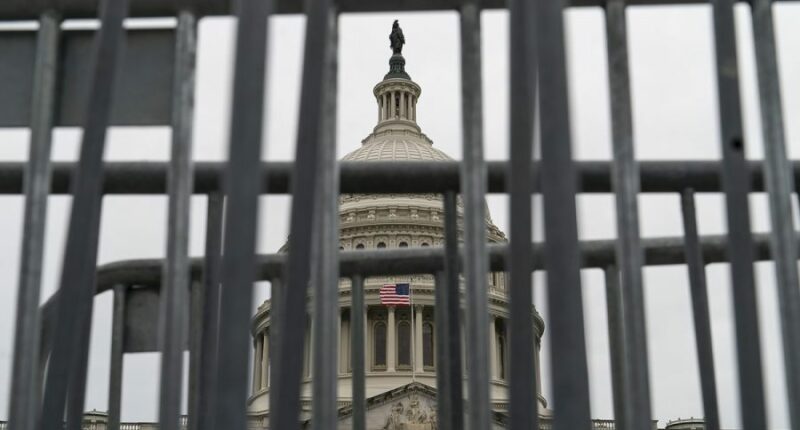Share this @internewscast.com

(The Hill) – The government shut down at 12:01 a.m. Wednesday after lawmakers did little to prevent it over the last two days.
The Republicans are firm in their belief that their proposal to fund the government for the next seven weeks, which has already been passed by the GOP-led House, should be approved in the Senate without any additional conditions.
On the other hand, Democrats assert that their necessary support for passing the legislation in the Senate will only be provided if Republicans agree to make concessions on health care matters.
A Monday White House meeting between President Trump and the top congressional leaders in both parties achieved basically nothing.
This is the first shutdown since midway through Trump’s first term.
A government shutdown does not result in the immediate halt of all governmental activities. Services tied to mandatory spending, such as the distribution of Social Security benefits, continue. Additionally, “essential workers” remain on duty, although the definition of what constitutes ‘essential’ can be ambiguous.
Shutdowns do have immediate impacts, such as the potential closure of national parks and museums that rely on federal funding, with further effects increasing over time. In the previous shutdown that spanned late 2018 to early 2019, President Trump eventually relented after five weeks as the issues intensified.
Here are the five takeaways on how we got here and what it means.
Democratic leaders are under pressure from their base
The current shutdown fight can’t be understood without reference to what happened during a funding standoff in March.
At that time, Senate Minority Leader Chuck Schumer (D-N.Y.) opted to cooperate with Republicans to keep the government operating, concerned that a shutdown could lead to President Trump reducing government functions even further.
During this period, Elon Musk and his semi-official Department of Government Efficiency (DOGE) played a leading role within the administration in implementing significant budget cuts.
But the Schumer decision to go along with the GOP was massively unpopular with a liberal base that, then and now, sees Trump as a danger to democracy itself. It also caused significant angst between Senate Democrats and their counterparts in the House, who generally wanted a harder line.
This time around, Schumer — who is himself looking over his shoulder at the possibility of a primary challenge from progressive standard-bearer Rep. Alexandria Ocasio-Cortez (D-N.Y.) — is under pressure to put up far more of a fight.
A New York Times/Siena College poll released Tuesday found that a slim plurality of Democratic voters — 47 percent to 43 percent — believes their party should shut down the government if their demands are not met.
This is starkly different from the view among the overall electorate, which opposes a shutdown on such a basis by almost 40 points.
Republicans have little incentive to bend
It’s understandable, viewed through a political lens, why Democrats don’t want to bend. But whether they have a winning hand is far more doubtful.
Republicans appear relatively unbothered by the threat of a shutdown. Primarily that’s because they argue that Democrats will get blamed by voters for any negative effects.
The thinking here is that the party that tries to leverage a shutdown generally loses in the court of public opinion.
Trump’s efforts in 2018 and 2019 were predicated on the idea that a government shutdown would pressure Democrats to fund his signature border wall. His gambit didn’t work. The Democrats didn’t buckle and, in the end, Trump did.
Republicans can play the blame game in other ways, too. Democrats have in the past insisted that what is technically known as a “clean CR” — a measure to keep the government running without new conditions — should be passed as a matter of course. Now, they’re saying it shouldn’t.
There are still some dangers for the GOP, however.
One is the plausible possibility that voters will blame the party that holds the White House, the Senate and the House for a shutdown.
Another is that the Democratic focus on health care cuts will deepen the unpopularity of the Trump-inspired spending bill that contained those cuts, which passed earlier this year.
Trump seems willing to slash workers
A key dynamic in the shutdown clash is that Trump himself, and the people around him, are basically hostile to government workers.
The attitude had its most obvious manifestation in Musk and his shock-and-awe approach to cuts earlier this year.
But in the current context it has also found expression in threats from Trump and White House budget director Russell Vought to lay off workers permanently, rather than merely furloughing them, as is more normal during shutdowns.
“We can do things during the shutdown that are irreversible, that are bad for them [Democrats] and irreversible by them,” Trump told reporters at the White House. “Like cutting vast numbers of people out.”
Vought, the director of the Office of Management and Budget, sent a memo to agencies last week instructing them to figure out what areas of activity could see jobs permanently eliminated.
The big picture: The hollowing-out of the center ground
The minutiae of the looming shutdown is of limited interest to most Americans.
But the bigger picture here is that the standoff is one more example of how far apart the parties have become.
In a process that has been many years in the making, the bases of each party increasingly reward confrontation and see conciliation as suspect.
There’s nothing inherently malevolent about that — it could in fact be seen as a rational response from parties that see the world in radically different ways.
But the practical reality is that it makes governing harder within the American system of checks and balances, and divided government. That goes for shutdowns, for other even more far-reaching issues like the possibility of a debt default, and for passing legislation generally.
So, how does it all end?
Who knows?
The Beltway conventional wisdom is that Democrats will hold firm for a while, to at least make their point about resistance to Trump. But unless they enjoy an unexpected degree of success in putting the blame on the GOP, they may have to yield eventually.
One sliver of hope for a resolution is that there are a small number of Republicans who seem to be open to some version of the key Democratic demand — the extension of enhanced subsidies for enrollees under the Affordable Care Act.
There could be seeds of a compromise there. But it will take a while, if ever, before they flower.













